The idea of a trip to the Wine Routes of Northern Greece had been under consideration for some time by the members of the Management Board of the Cyprus Oenophile Association.
After several consultations and research, it was decided to implement this idea and preparations for the trip began.
The trip was entirely organized by the Greek general tourism office “Seavilization” which specializes in wine tourism and other thematic tours and our guide was the owner of the office, Mrs Despina Papadima.
Thus, on Wednesday, 1st October 2008, our decision took shape and 28 lucky members of the Association, were given the opportunity to live a unique travel experience.
Wednesday, 1st October
We started our journey late in the afternoon from Larnaca airport, and in almost two hours we arrived at Macedonia airport, in Thessaloniki. We quickly settled in at the five-star hotel “Porto Palace”, in Thessaloniki, where we had dinner.
During our dinner, we were privileged to meet Mr Stelios Boutaris, from the well-known Kir-Yianni Estate of Yiannakochori, Naoussa. Mr Boutaris is the son of Yannis Boutaris, the man who essentially brought the Xinomavro grape variety to Greece as the dominant variety of Northern Greece.
As his Estate was not included in the list of wineries we had planned to visit, we were given the opportunity to make arrangements to this effect during our dinner.
Our dinner began with a welcome drink of rosé sparkling wine from the Union of Agricultural Cooperatives of Amyndeon, produced exclusively from Xinomavro. It was followed by a meal of Mousakka, accompanied by the unique Greek rosé wine “Akakies 2007” of Kyr-Yianni’s Estate, a “Wine of Designation of Origin of Superior Quality”. Then followed a salad and roast lamb with potatoes. We tasted the red dry wines Ramnista 2005, which come exclusively from old Xinomavro vines, and the Diaporos 2005, made from 87% Xinomavro and 13% Syrah, both with an alcoholic strength of 14.8%.
Thursday, 2nd October
Our second day was dedicated to the Vivlia Chora Estate and the wineries of the Dionysos route, located in the Drama region.
We started our wine tour at the Vivlia Chora Estate located in Kokkinochori, Kavala, just after the river Strimonas, on the slopes of Paggaio Mt, a place which Hesiod, Theocritus, and Michael Psellus called “Vivlia Chora”.
In this area, the oenologists Vangelis Yerovassiliou and Vassilis Tsaktsarlis established a model vineyard of 250 decares with local and foreign varieties that produce the Local Wines of Paggaio. They also cooperate with other estates that have 100 decares.
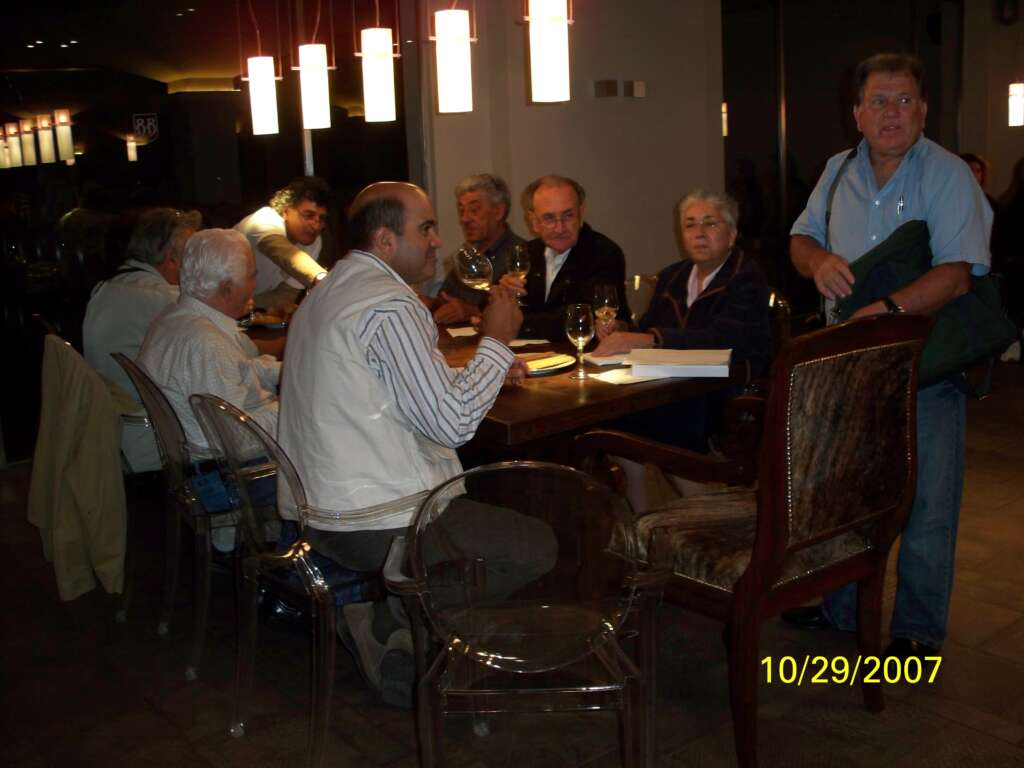
Mr Tsaktsarlis gave us a tour around the linear vineyard where the varieties Assyrtiko, Agiorgitiko, Sauvignon Blanc, Chardonnay, Semillon, Syrah, Merlot, and Cabernet Sauvignon are cultivated, and we visited the beautiful winery with the latest equipment and beautiful architecture. We visited the underground wine cellars with the oak barrels. We tasted the wines Ovilos, Ktima Vivlia Chora White and Red, and the wine Areti named after the daughter of one of the Estate’s owners, Mr Vangelis Yerovassiliou.
We continued our journey to the Mikrochori of Drama, where a new winery, the “Wine Art” Estate (ΚΤΗΜΑ “ΤΕΧΝΗ ΟΙΝΟΥ”), exploits the microclimate of the region and produces excellent quality wines (180,000 bottles per year) thanks to the personal initiative and passion of winemakers Yannis Papadopoulos and Yannis Kalaitzidis.

We were given a tour of this winery of exceptional beauty, with its two stone towers offering a panoramic view of the estate’s vineyards and the underground wine cellars where the rich, full-bodied red wines are matured. The stone used for building the cellars and the specially designed areas for storing the bottles was impressive.
We tasted the white, rosé, and the red wine of the “Techni Alypias” (“Art of Alypia”) range, so named because, according to ancient texts, Dionysus gave wine to people to forget their sorrow. We also tasted the Merlot and Chardonnay from the “Idisma Dryos” range. Idisma Drios is a name that reflects the rich sweetness imparted by the oak barrel to the flavour and aroma of the wine.
We continued with a visit to Lazaridis Estate, which is spread over 2200 decares and is located on the slopes of Adriani, embraced by the mountains of Falacro (Bald Mountain), Menoikio, and Paggaio. We visited the exemplary linear vineyard with its generous soils and ideal microclimate, which, being cultivated with care and maintaining a low yield per decare, produces the fine raw material for the wines and spirits produced by the estate, 20% of which are exported to 12 countries abroad, including Cyprus.
Next, we visited the spectacular winery, with a total surface area of 15,000 square meters, the distillery, and the underground ageing cellars. The barrel cellar for the red wines is one of the most important parts of the underground facilities of the Estate. Here the wines spend a period of time in 225-litre oak barrels before being bottled and stored under constant temperature and humidity conditions to reach their peak maturity and flavour through ageing.
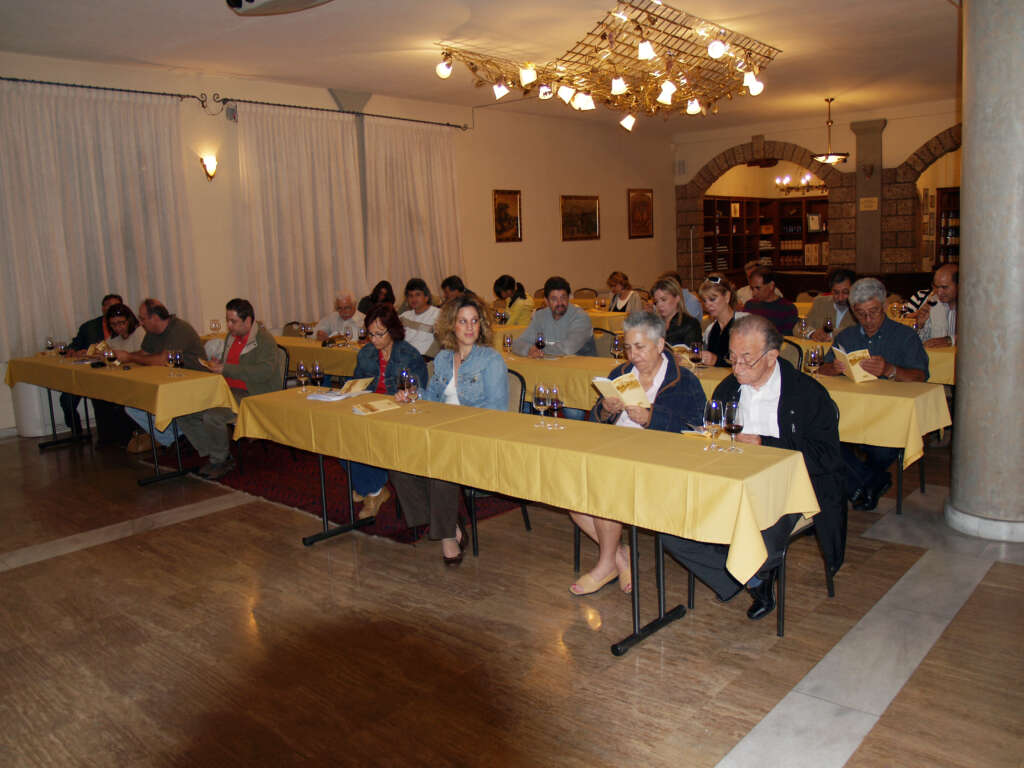
The Estate’s wine labels were designed by the painter and architect Yannis Nano, who gave the name to the “Amethystos” range.
In the special reception areas, equipped with all the necessary audiovisual equipment, we tasted the Amethystos Red 2006, 2001, and 2007, and the Ayiorgitiko 2005, produced by the second Estate owned by the company in Kapandriti Attica, the Oenotria Earth Estate.
We enjoyed a traditional lunch at the winery’s restaurant, including delicious kourabiedes and local sweets.
On leaving, most of us bought several Magnums to guarantee more wine tasting encounters after our return to Cyprus.
Afterwards, despite the late hour and our fatigue, we visited the Pavlidis Estate, located at the outskirts of Mount Falacros, not far from the Aggitis cave and the ski resort of Falacros.
The Estate’s linear vineyard takes full advantage of the sun due to its southwestern orientation. At the same time, in the summer, it receives the favourable influence of the afternoon north breeze, decisive for the smooth ripening of the grapes. Today, the Estate’s single-vineyard covers an area of 200 decares, with the prospect of systematic expansion, and is home to the Greek varieties Assyrtiko, Agiorgitiko and Limnio, the French varieties Sauvignon Blanc, Chardonnay, Syrah, Cabernet Sauvignon and Merlot and the Spanish Tempranillo.
Malagouzia and Mavrodaphne are grown on an experimental level, which will form the basis of the estate’s next wine production. In addition, part of the vineyard yields organically grown grapes and plant protection practices throughout the vineyard are environmentally and consumer-friendly.
We were shown around the Estate’s facilities, distinguished by simple lines and very modern style and were invited to the impressive tasting room in the basement where we tasted the Estate’s wines. This room also housed the barrels and the owner’s private wine collection.
Mr Nikos Karatzas, a Chemical Engineer and Oenologist, presented us with almost all the wines of the Estate. We tasted the whole Thema range and the Assyrtiko, the Chardonnay 2007, the Syrah 2006, the Tempranillo 2006 and the Syrah with Ayiorgitiko.
We returned to our hotel around 10:00 am, truly impressed by the Estates we had visited and their wines and by the progress made by Greek winemakers in recent years.
Friday, 3rd October
We left our hotel first thing in the morning at around 9:00 am and started our wine tour from Epanomi and the famous Ktima Gerovassiliou. Vangelis Gerovassiliou’s 500 decares of meticulously-tended vineyards overlook the endless blue of Thermaikos Gulf. There we saw the indigenous varieties Limnio, considered the oldest Greek variety, the Mavroudi and Mavrotragano varieties, the unique Malagouzia and the international varieties Merlot, Sauvignon blanc, Chardonnay and Viognier.
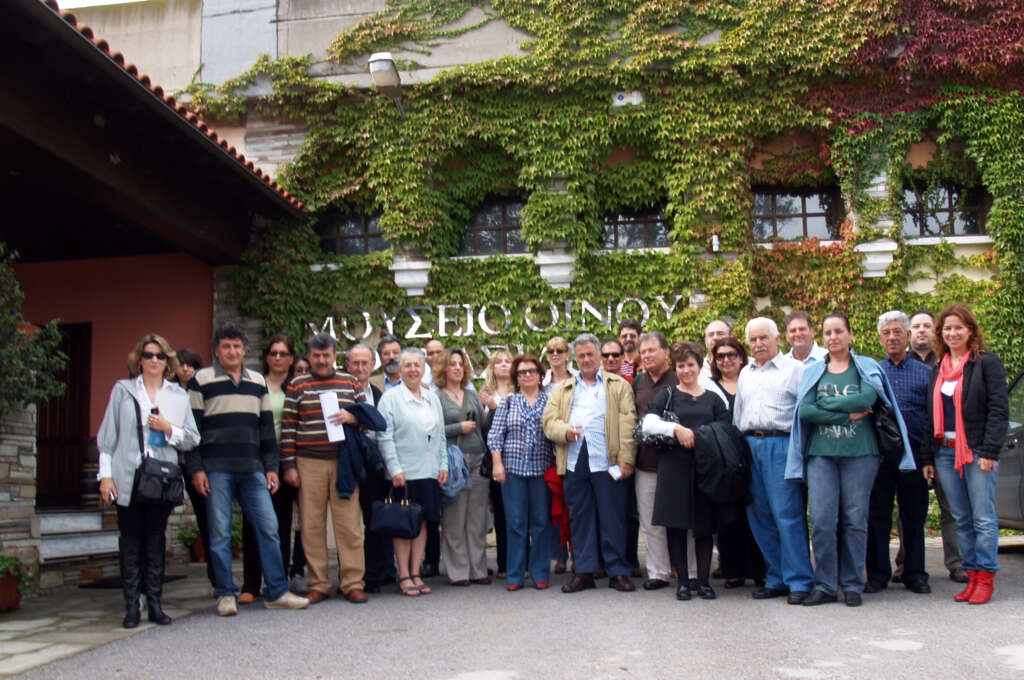
Vangelis Gerovassiliou guarantees the production of high-quality wines, from determining the time of harvest, the processing of the grapes in stainless steel crushers, the careful pressing in pneumatic presses, the thermal control of the fermentation to the ageing in oak barrels and bottling.
Entering the Estate, we were particularly impressed by the attractive garden filled with aromatic plants and rose bushes.
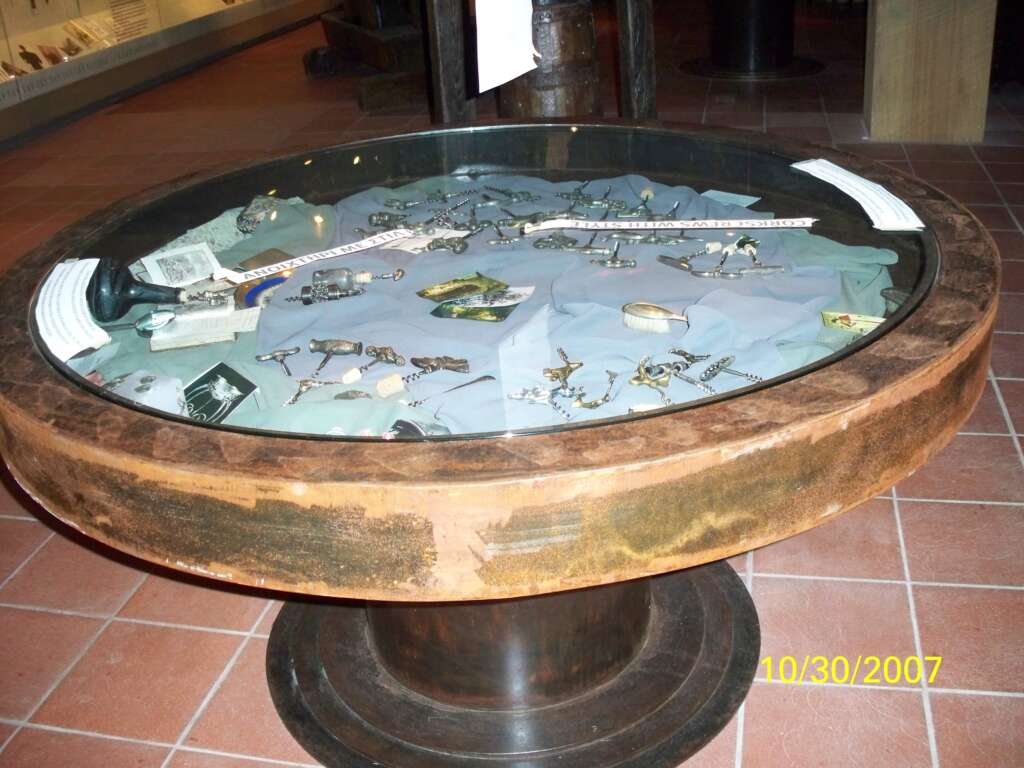
After visiting the wine production and ageing areas, we visited the distinguished Wine Museum of the Estate, where old wine objects are exhibited. Upon entering the museum, one can perceive that it was designed by a museologist particularly knowledgeable on the subject. We admired the extraordinary collection of 1,800 wine openers, rare bottles and period wine-making machinery.
In the inviting tasting room, we enjoyed the White 2007, Chardonnay 2007 and the last two remaining bottles of the Avaton. We asked if we could taste the Evangelo, a limited release wine made from Syrah and Viognier grapes; however, this proved impossible as it was quickly sold out following its release in the market.
Leaving the tasting room, we all admired the beautiful Chandelier made from green bottlenecks, decorating the winery’s dining room ceiling.
We left the sea and headed to the beautiful mountainous Halkidiki, where we visited the brand-new Domaine of Claudia Papagianni, located on the outskirts of Arnea.
The Domaine’s privately-owned vineyards were planted in 2003 with both international and Greek varieties: red Syrah, Merlot, Cabernet Sauvignon, Grenache, Xinomavro and the white Chardonnay, Malagouzia and Assyrtiko according to the rules of organic farming.
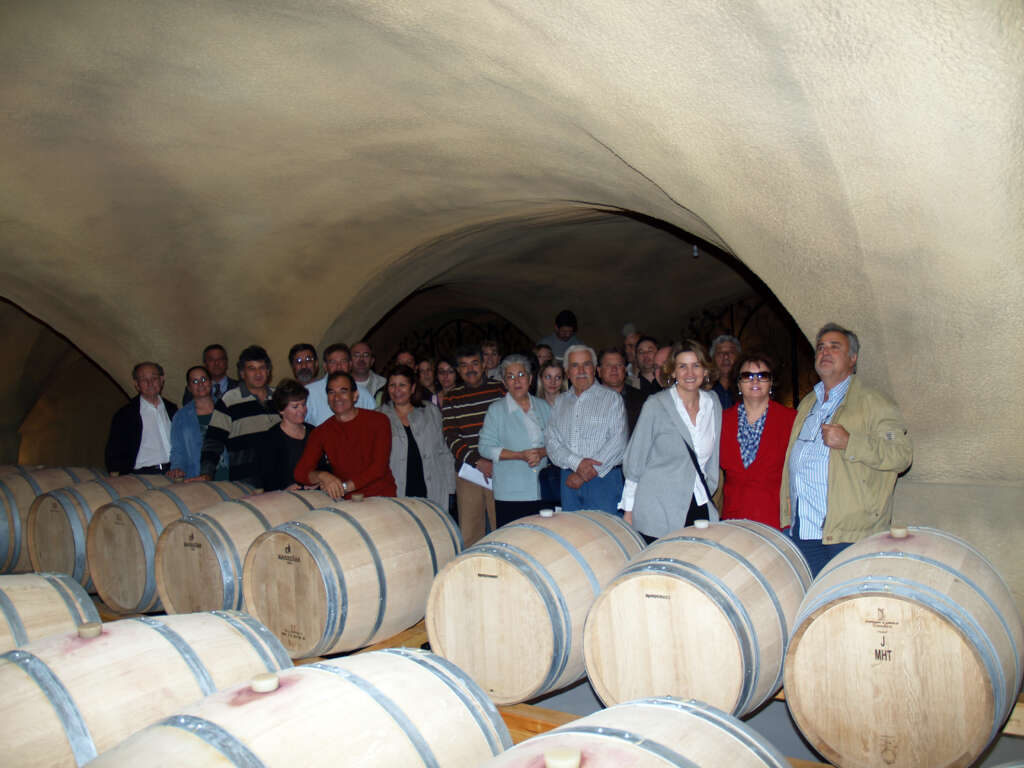
The winery has all the modern equipment and a vast and beautiful underground cellar for the ageing of the wines. It also includes a multi-themed room, a tasting room and a showroom with traditional local products of the region.
The unique microclimate, the rich soil, the altitude of the area where the vineyards are located, the well-planned selection of international and indigenous varieties, the controlled limited yield of the vineyard, the use of the latest technology in winemaking and the highly qualified staff are all part of the philosophy of the Papagianni family, to ensure the best possible quality of its wines, aiming at international recognition.
We tasted the cosmopolitan Sauvignon Blanc, the Assyrtiko and the Merlot aged for 12 months in French oak barrels.
We left the winery and headed to Ayia Paraskevi, set in a forest of plane trees. At the traditional tavern Boukatsianos, in the woods, we enjoyed a Lucullian fare, which consisted of wild boar stew and roast lamb in addition to the excellent salad. We had a delicious vanilla ice cream with syrup for dessert, served on a perfect cookie.
We returned around 7:00 pm to Thessaloniki, where some of us had the opportunity to visit the city’s famous market, and others chose to relax on the hotel’s premises.
Late in the evening, our “card players” visited the casino and the rest of us visited other entertainment venues.
Saturday, 4th October
We left our hotel at 10:00 in the morning to visit the mountainous area of Thessaloniki. In a forest of oaks, cherry and blackberry trees, we encountered Arvanitidis Winery and Babatzimopoulos Estate. We started our visit with Arvanitidis Winery located at Askos, a small, quiet village near Thessaloniki, situated at an altitude of 500 meters on the eastern slopes of Mt. Vertiskos, a few kilometres before Sohos, renowned for its famous kasseri cheese and carnivals.
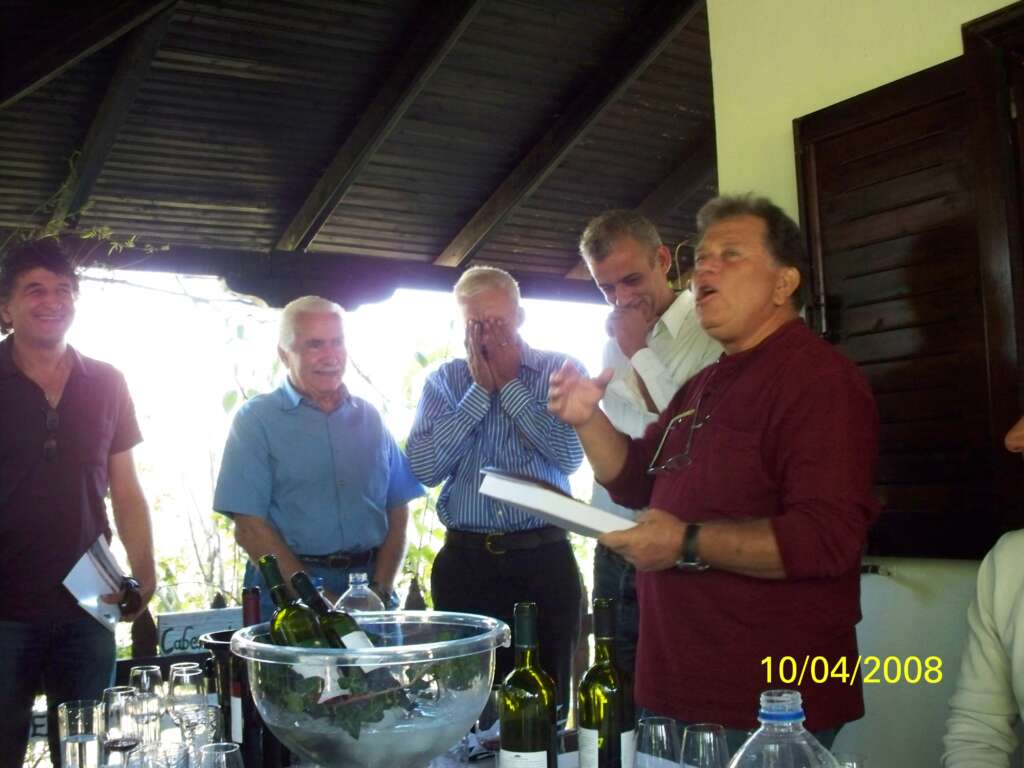
The winery was founded in 1999 by agronomist Thanasis Arvanitidis and his brother George, who planted the first 10 decares of their privately owned vineyard in this beautiful semi-mountainous area. Today the site has reached 40 decares. There is a prospect of systematic expansion to cover the production exclusively from privately owned vines so that the quality of the raw material is always controlled.
To produce the winery’s wines, both cosmopolitan and less widespread varieties of vines were selected, and their plantation in the vineyards was based on their soil and climate needs.
After we toured the winery, we were hosted on the picturesque terrace of the family house, which is located in a lush green garden. We tasted the Chardonnay 2006 and 2007 and the Cabernet Sauvignon – Merlot of 2005 accompanied by fine cheeses.
Our second stop was the famous Estate of Anestis Babatzimopoulos, located on Mount Vertiskos in Ossa.
The Babajimopoulos business was founded in 1876 in Istanbul. It maintained privately owned vineyards in the Deleones of Silivria and mainly engaged in the production and distillation of raki and export of wines.
In Ossa, at an altitude of 620 metres, amidst an oak forest, on a total area of 550 decares, a 250-decare organic vineyard was planted with Chardonnay, Merlot, Malagouzia, Roditis, Cinsault, Xinomavro and Cabernet Sauvignon. A new winery and distillery were established in the vineyard to produce the Estate’s organic products.
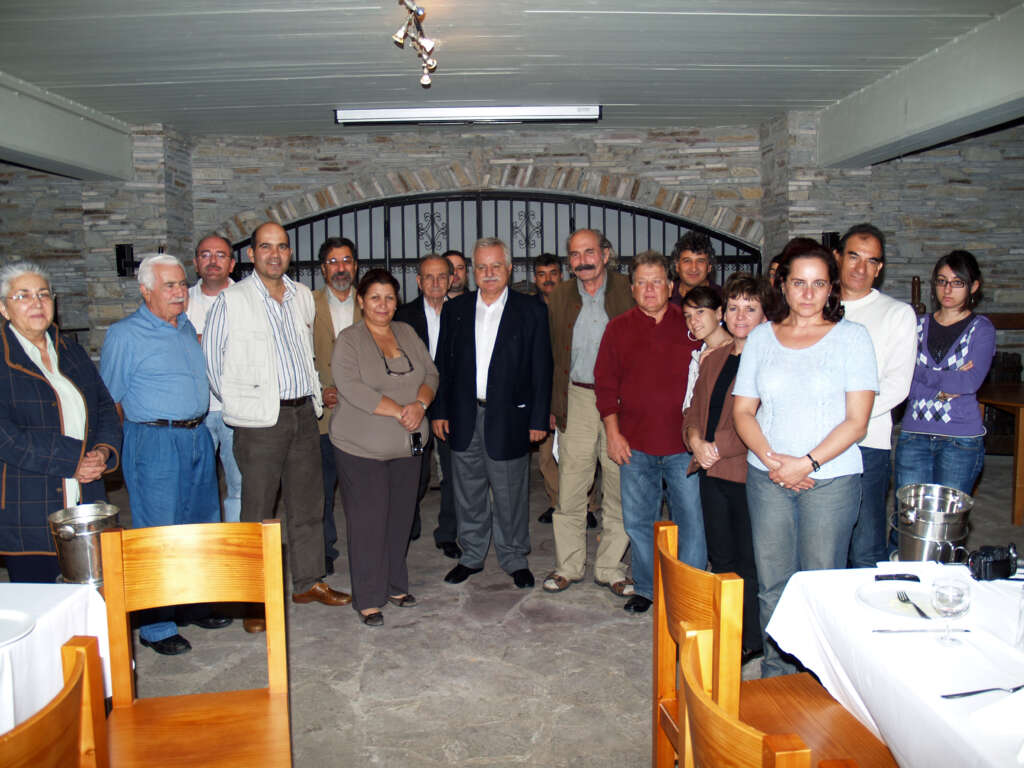
We were welcomed by Mr Anestis himself, a man with a special gift for communication, a unique personality, friendly and philosophical. During the lunch that followed, he said: “I have made my work my life and my life my work. I have achieved a balance in my life, and now I don’t understand anything“.
We were shown around the Estate’s distillery, where tsipouro and grape distillate is produced, and then visited the beautiful Estate and its winery.
At the traditional meal that followed, apart from the delicate dishes, we tasted the Estate’s wines which had something of Mr Babatzimopoulos’ vivid character. During lunch, we had the opportunity to meet Mr Yannis Glavakis, a Member of the European Parliament (MEP) of the New Democracy party (ND), a personal friend of Mr Babatzimopoulos. He invited us to visit the European Parliament in Brussels.
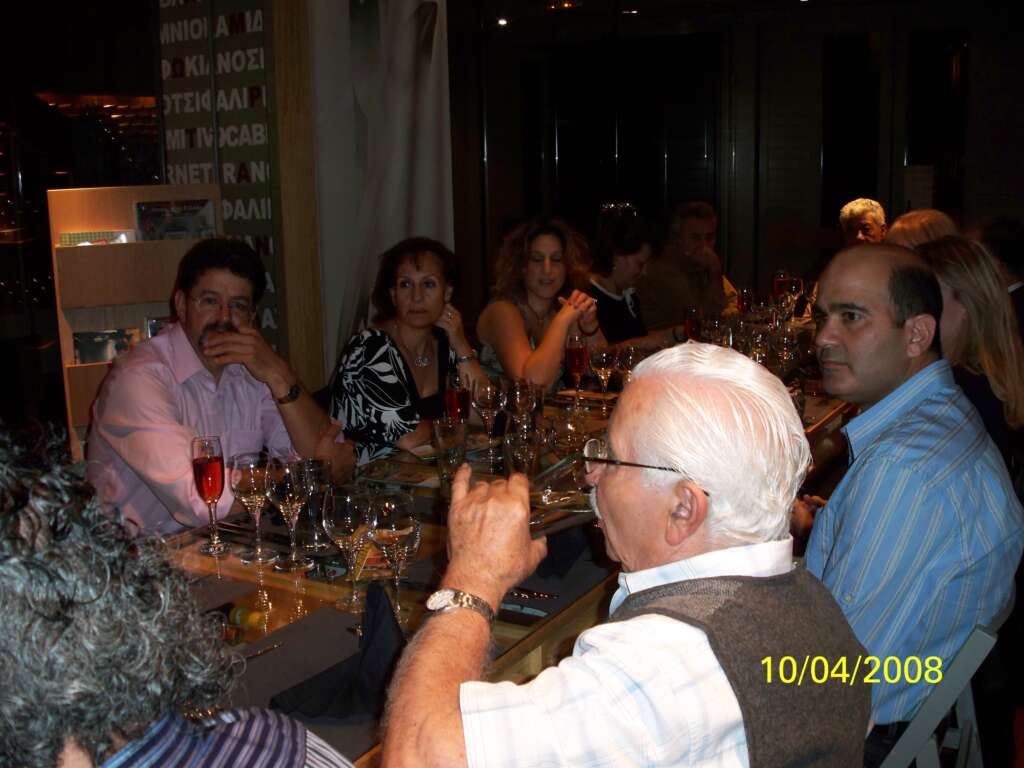
We returned to Thessaloniki, where some chose to visit the Cosmos Mall and others decided to relax.
In the evening, all 28 members of the group experienced the ultimate oenogastronomic experience at the wine cellar of Yamas, a multi-purpose venue located near Thessaloniki beach.
There, we lived an amazing food and wine pairing experience, leaving us with indelible taste memories.
We started our dinner with some sparkling Anna Maria Glinavos wine, as a welcome drink by Seavilization Travel. We continued with oven-baked pike garnished with basil sauce, grilled grouper with petimezi sauce and Santorini fava beans, followed by risotto with porcini mushrooms and strawberries. As the main course, we had braised calf’s tail.
Along with the food, we tasted the Traminer and Averoff Rosé wines from Katogi Averoff, the Apiros Chora and the Kokkino Veloudo from Glinavos winery. This was followed by cheeses with cold cuts and for dessert, we had cream cheese with traditional sweet rose treat accompanied with Melifronos wine of Katogi Averoff.
The restaurant’s chef presented the dishes and Ms Maria Dimou, Public Relations Manager of Katogi Averoff Estate presented the wines of the Estate. We were joined by the head of the Wine Routes of Northern Greece program, Ms Anthidou.
The service was of an exceptionally high standard and left the best impressions even to the most demanding of the group.
Sunday, 5th October
Sunday morning was free for a stroll in the beautiful streets of Thessaloniki. We were so overwhelmed by what we had seen, tasted and experienced during our excursion to the Wine Roads of Northern Greece that most of us preferred to relax at the hotel.
To be properly enjoyed, all good things in life should last as long as they need to. That is why we, too, began our return journey from Macedonia airport to Larnaca with a promise to do more trips in the future to other vineyards and wineries of the world.
We are looking forward to our future travel destinations, that will furnish us with even more knowledge and experiences to compare with all that we have experienced on this journey.
* Written by the Gen. Secretary of the Association, Yiannoula Vassiliadou from personal notes taken during the trip and material found on the internet and in the brochures of the various wineries visited.
